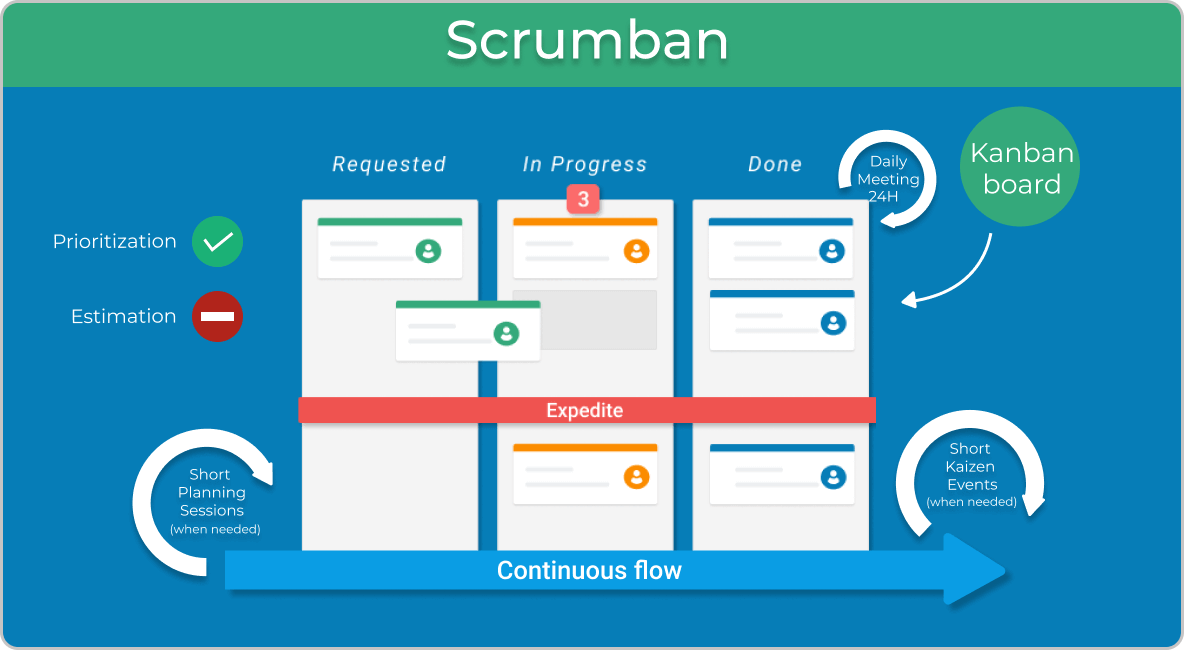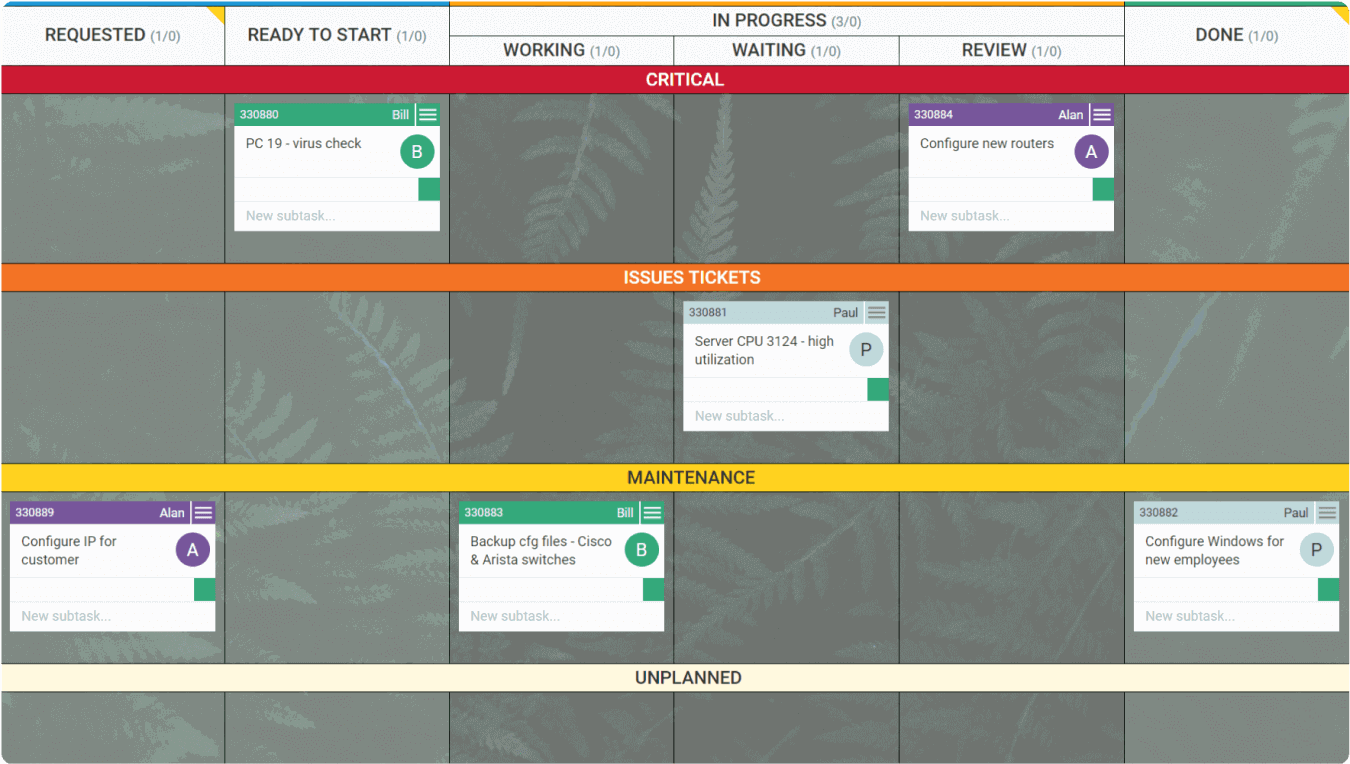Are you looking to enhance your team's productivity and adaptability? Look no further! In today's post, we explore Scrumban, the agile methodology that merges Scrum's predictability with Kanban's flexibility. We'll cover the benefits of Scrumban, its applications, and the reasons it's becoming a go-to for teams worldwide. Stay tuned as we break down the Scrumban process with the help of five easy-to-follow practices for seamless integration into your projects.
What Is Scrumban?
Scrumban is an Agile approach to project management that combines the Scrum framework and the Kanban method. Corey Ladas developed and presented it in the book Scrumban: Essays on Kanban Systems for Lean Software Development.
Scrumban represents a way for Scrum teams to increase their Agile maturity by optimizing workflows and embracing Lean and Kanban practices. The approach can be advantageous in terms of time-saving as plans are made only when demand occurs. To dive deeper into Scrumban, let's first recap its constituting parts - Scrum and Kanban.
What Is Scrum?
Scrum is an Agile project management framework that focuses on time-boxed sprints for work management. At the end of each iteration, the goal is to produce a "potentially shippable product" and gather customer feedback.
Scrum is defined by artifacts, ceremonies, and Agile roles typical for a Scrum team. Every Scrum project process begins with the Product Backlog, which is a container for all customer requirements. Next, teams commit to the work that could be finished by the end of the iteration and place it in a Sprint Backlog. Once the sprint begins, they start working on the committed work items to create a working functionality and increment.
Scrum is predominantly used across product development teams, specifically software engineering. Its purpose is to help teams adapt to project changes, decrease delivery times, and meet customers' requirements. Some of the main benefits of Scrum include adaptability, accelerated product delivery, improved ROI, etc.
What Is Kanban?
Kanban is a workflow management method that focuses on continuous flow to manage work. Unlike Scrum, Kanban doesn't prescribe fixed timeboxes. Instead, teams can deliver as soon as they're done with their work. Furthermore, Kanban has no strictly defined roles or ceremonies, making it highly adaptable to various project scenarios.
The primary purpose of the Kanban method is to uncover inefficiencies (ex. bottlenecks) to accelerate project delivery and make the work "flow" so teams can achieve predictability. This happens by first visualizing work on kanban boards to map and analyze the entire value stream. Kanban aims to limit the work in progress. The idea is to focus on finishing the current work assignments before starting new ones, which increases delivery rates while reducing cycle times.
Some of the main benefits of Kanban include improved work transparency, adaptability to changing priorities or requirements, scalability across the entire organization, predictability in product/service delivery, etc.
How to Use Kanban and Scrum? 6 Important Concepts
Managers should explore their teams' needs to use Scrum and Kanban together. For example, Scrum could be more suitable for processes where the focus is only on building a product that needs to be released at a given interval. Kanban would work better in a scenario where priorities frequently change, and work enters the process ad hoc.
If you wish to introduce flow into your Scrum implementation, start with the concepts below.
- Improve Workflow Visualization: Visualize every work activity/stage that an item goes through.
- Limit Work In Progress: Limit how much work teams can have in every single work stage.
- Manage Flow: Introduce flow principles inside iterations.
- Make Process Policies Explicit: Create and visualize work policies that communicate the needs of the process.
- Implement Feedback Loops: Analyze flow data as part of appropriate Scrum ceremonies (ex. Agile retrospectives).
- Improve Collaboratively: Test and evolve your working practices constantly to discover the best fit for your unique process.

How Scrumban Works? 5 Key Practices Explained
Scrumban works by merging Scrum's predictive structure with the Kanban method's flexibility. The approach aims to enhance Scrum teams' Agile maturity and help them transition to "pull" ways of working to deliver continuous customer value. By following the steps below, you can start gradually applying Scrumban within your process.
- Create a Scrumban board
- Impose WIP (Work In Progress) limits
- Improve prioritization on the board
- Move from estimating to flow-based metrics
- Embrace flexible feedback loops
Let's briefly go over each one of them.
1. Create a Scrumban Board
A Scrumban board represents an evolved Scrum board. It resembles the kanban board, with the exception that teams still organize their work in iterations. Scrumban borrows the Kanban concept of complete workflow visualization and recommends that Scrum teams go beyond the ordinary workflow stages/columns ("To Do", "Doing," and "Done"). This means capturing the entire work process by including stages such as "Design/Analysis", "Development", "Ready for review", "Testing," etc. This helps you inspect where work items slow down so you can spot inefficiencies in the iterations.
2. Impose WIP (Work-In-Progress) Limits
Scrum limits the time, while Kanban answers how many assignments can be worked on simultaneously. Scrumban takes both these concepts and combines them. The goal is to create better efficiency within iterations by focusing the team's attention on finishing the current work assignments before starting new ones.
To do all this, Scrum teams should start imposing limits on the stages/columns of their workflows to define how many work items can reside there. Once the limit is reached, team members are encouraged to help their peers instead of starting work on another item. As a result, you will begin to see a more collaborative environment with improved productivity.
As a result, the practice of setting WIP limits will help you create an environment where teams continuously pull work from the backlog and deliver customer value without having to stop the process due to iterations.
3. Improve Prioritization on the Board
Once you have evolved your board, it's time to separate different types of work. This can happen by introducing horizontal lanes to distinguish more critical work items from the standard ones. You can also start introducing different visual tokens (ex., stickers) to mark your work with specific labels. As a result, you will better prioritize work that needs special attention (ex., a PBI that holds a bigger risk that you need to mitigate as soon as possible). This can also give you valuable insights on how to best allocate your team's capacity.
 Using WIP limits and swimlanes to set priorities on a work management board in Businessmap
Using WIP limits and swimlanes to set priorities on a work management board in Businessmap
4. Move from Estimating to Flow-Based Metrics
Another key concept of Scrumban is to start managing flow within iterations. This can happen by tracking the time it took for PBIs to complete (cycle time) and how many were delivered (throughput), or using the flow metrics. This gives more workflow information to teams than velocity measurements which are based on estimating the size (in story points) of backlog items. As a result, they can start using actual delivery data (not estimations) to plan what could be done in iterations.
5. Embrace Flexible Feedback Loops
Unlike Scrum, where there are strict ceremonies, in Scrumban, you can adapt the feedback loops to your needs. As you embrace continuous flow, you can replace the Sprint Planning meeting with shorter replenishment sessions to determine what work to execute next. In Scrumban, teams still use Agile retrospectives and daily stand-up meetings. However, their purpose moves to an Agile context where the focus is to analyze the flow performance in a given period.
What Are the Advantages of Scrumban?
Some of the main advantages of Scrumban are listed below.
- Optimized Planning: Scrumban helps teams save time due to the shift toward continuous flow. By integrating pull-based practices (through limiting WIP), teams start planning based on incoming demand. Furthermore, due to embracing flow metrics, Scrumban teams rely on historical data to make predictions. This allows them to save a lot of time in estimating the size of individual work items.
- Easier Bottlenecks Identification: Scrumban aims to evolve the Scrum board and turn it into a kanban board. The idea is to map the entire flow of work items throughout the process. This means visualizing all work stages apart from the standard ones: "To Do", "Doing", "Done". As a result, teams can identify bottlenecks in the process and alleviate them to speed up the flow of value to the market.
- Enhanced Clarity: In Scrumban, the complete workflow visualization is achieved by mapping all work stages on comprehensive boards. This provides more clarity to the process and allows all team members to be on the same page. The boards act as "radiators" of information, contributing to faster status updates.
- Improved Efficiency in Managing Large Projects: As a result of using boards in Scrumban, teams can better organize workflow management of large projects. Besides visualizing all work stages, they divide their boards on horizontal lanes, separating work items with higher urgency, fixed-delivery dates, etc. Scrumban also borrows many kanban analytics, such as the Cumulative Flow Diagram, Cycle Time Scatter Plot, Blocker Clustering Charts, etc., which help teams extract valuable information about the progress and issues of their projects. By analyzing that information, they can make better decisions to improve the efficiency of their work process.
- Increased Team Autonomy: Due to the integration of pull principles, Scrumban teams have more autonomy in making their own local decisions about which work items to execute next. This gives them independence and increases their morale while reducing the stress in the work process.
When Should a Team Use Scrumban?
Scrumban can be used for long-term projects that require ongoing maintenance. That's because once a product has been released with Scrum, maintenance work could come unpredictably inside the process. This requires more flexibility for teams to pull work only when there is demand for it.
Scrumban is also suitable for larger projects with a complex structure and many different work types that need to be prioritized. Furthermore, many teams move to Scrumban and eventually Kanban when they are looking to adapt their current process to a given way of working, not vice versa.
What Is the Difference Between Scrum and Scrumban?
The difference between Scrum and Scrumban is that the former focuses on strict iterations, while the latter looks to transform them gradually into a continuous flow. One advantage of Scrumban over Scrum is that it gives more freedom for teams to engage in planning sessions only when there is a need for them. This happens due to the introduction of continuous flow and "pull" ways of working.
Furthermore, Scrumban aims to significantly reduce the time spent on Scrum estimations by introducing flow metrics. On the other hand, Scrum is a more rigid process in which teams agree on a predefined delivery interval. It benefits one-off and shorter-term projects where the goal is to deliver a working product as soon as possible.
What Is the Difference Between Kanban and Scrumban?
The difference between Kanban and Scrumban is that the former fully embraces continuous flow, while the latter still uses iterations. As Scrumban aims to move a Scrum team to Kanban, both approaches are suitable for longer-term projects that require ongoing maintenance. Unlike Scrumban, where teams still have a predefined process (ceremonies, roles), Kanban offers an entirely tailor-made approach. This enables teams to evolve (not revolutionize) their current work management systems and achieve organizational agility.
Try Businessmap Free for 14 days
Nikolay Tsonev
Product Marketing | PMI Agile | SAFe Agilist certified
Nick is a seasoned product marketer and subject matter expert at Businessmap, specializing in OKRs, strategy execution, and Lean management. Passionate about continuous improvement, he has authored numerous resources on modern-day management. As a certified PMI practitioner and SAFe Agilist, Nick frequently shares his insights at Lean/Agile conferences and management forums.



